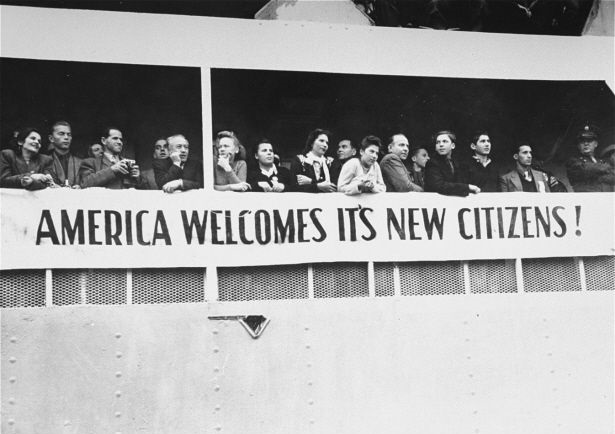
Background
Image credit: United States Holocaust Memorial Museum
National Origins Quota Act of 1924
The United States has debated immigration policy all the way back to its founding days. During periods of fear and tension the nation has often resorted to restricting immigration. One such example was the Immigration Act of 1924, which was signed into law on May 26, 1924 by Calvin Coolidge. The aftermath of WWI featured both an economic recession and fears of communism. Restricting immigration seemed to make sense during this time of uncertainty.
This law also established the principle of immigration quotas based upon a person’s nationality. It restricted the number of immigrants to the United States from a given country to 2% of that group’s population in the nation. The new quota system was based on records from the 1890 census instead of the current population numbers. This calculation favored people from North-Western Europe, ensuring that the majority of immigration visas would be issued to immigrants from Britain, Ireland, Germany and Scandinavia, instead of those from Eastern Europe or other areas of the world. The law completely excluded Arab and Asian immigrants, which infuriated the nation of Japan. It also frustrated many American citizens, such as Representative Robert H. Clancy, a Congressman from Detroit, Michigan, who called the Quota Act “a racially discriminatory and un-American“ policy.
Immigration and Nationality Act of 1952 (McCarran-Walter Act)
Immigration policy wasn’t closely examined again until after WWII. New legislation was introduced in 1952 by Democrats Pat McCarran and Francis Walter. This McCarran-Walter Act was officially named the Immigration and Nationality Act of 1952 and had several provisions. Perhaps most importantly, the Act continued the quota system put in place in 1924, this time basing quotas on the 1920 census. These quotas continued preferences for immigrants from Northern and Western European nations while greatly limiting immigrants from other parts of the world. The 1952 Act also encouraged immigrants who had special skills or who were relatives of American citizens.
The 1952 bill was passed during a time of anxiety in the United States. Since the end of WWII, the US had already become engaged in an ideological conflict with the Soviet Union. By 1952, Joseph McCarthy had launched his crusade against communists in the US government, Truman’s loyalty program had been in effect for five years, and Truman and McCarran had already sparred with each other over the 1950 McCarran Internal Security Act. An essential goal of the proposed immigration law was to ensure that un-American or subversive individuals did not enter the United States. Under this new law, all immigrants would be screened for past participation in communist organizations.
Truman’s Decision
The bill passed both houses of Congress during the spring of 1952. President Truman received considerable feedback over the following weeks from Americans on both sides of the immigration debate. Like today, diverse groups of Americans held widely different beliefs about the topic, some focused on concerns about national security and others motivated by humanitarian crises across the world in the wake of World War II. Truman had a tough decision to make, knowing that he would upset citizens no matter what stance he took.
Key Question
Did the benefits of the Immigration and Nationality Act of 1952 outweigh the costs for the American people?
Materials
Documents to be examined:
- Memorandum, “Summary of McCarran-Walter Omnibus Immigration Bill,” June 11, 1952
- Memorandum from Attorney General James McGranery to Frederick J. Lawton, June 25, 1952
- Statement by Senator Pat McCarran, March 2, 1953
- Letter from Phyllis Craig to President Harry S. Truman, June 26, 1952
- Letter from Rabbi Max H. Leader et al. to President Harry S. Truman, May 28, 1952
- Memorandum from Harry N. Rosenfield to Harry S. Truman, June 12, 1952
- Letter from Leonard H. Pasqualicchio to Harry S. Truman, June 4, 1952
- Letter from Abe Hagiwara to Harry S. Truman, June 14, 1952
- Letter from William Hopkins to Rose Conway, August 4, 1952
- Proclamation by President Truman: Immigration Quotas, June 30, 1952